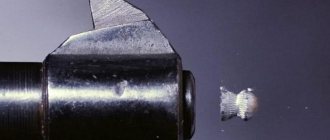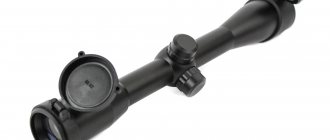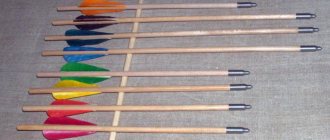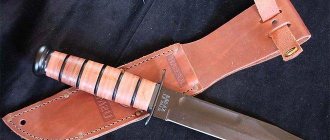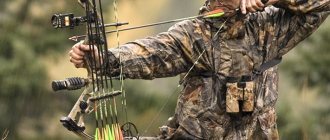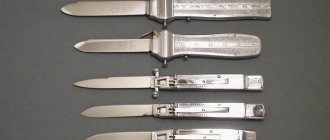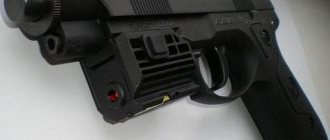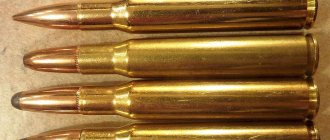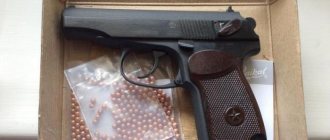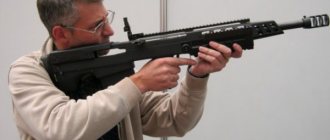And again, good day to everyone reading. Mentions regularly appear here regarding pneumatic ammunition, but there has not yet been a place for people to park, a point of possible discussion. In addition, stores are full of all kinds of bullets, and it can be simply difficult for beginners to navigate such “trash.” Let's try to streamline the topic a little and talk in general terms about bullets for air guns.
Let's agree a little on the names. Here and further we will call everything bullets: both rifle bullets and air pistol balls, so if something like this flashes somewhere, we close our eyes. In addition, some people do not like to call pneumatic bullets “bullets”, preferring a softer name like “bullets”. By the way, abroad the word “bullets” is used for firearms ammunition, and “pellets” for pneumatic ammunition.
Types and types of bullets for pneumatics
Pneumatic bullets with a caliber of 4.5 mm differ in shape and main purpose:
- Lead balls (Round). Used for recreational shooting. Can be used for multi-charge pneumatic models. They have high penetration ability and receive a rotational movement while passing through the barrel. They have good accuracy and a large mass - approximately 0.55 g.
- Copper-plated steel balls (BB). They are used for entertainment, have an average accuracy - about 4-6 cm from a distance of 10 m. They are used, as a rule, in multi-shot pneumatics (magazine or hopper), since they do not require orientation during feeding. The mass of the bullet is approximately 0.31-0.34 g. The caliber is in the range of 4.34-4.43 mm. Accuracy is worse, unlike lead balls, especially at significant distances. In the process of hitting the target, due to the lack of deformation, the bullet produces a more “powerful” effect, but is more prone to ricochet. It is not recommended to use it for pneumatics with a rifled barrel, this leads to rapid wear.
- Lead bullets with a hemispherical head (Domed). This is a universal form that is used for hunting and sport shooting. They are characterized by good accuracy while maintaining maximum energy over significant distances due to high aerodynamic performance. They have high penetration ability.
- Lead bullets with flat head (Match). They are used for sports and training shooting at targets from a distance of up to 10 m. At short distances they can have a shock effect on small animals. When the bullet hits a paper target, it punches a clear, round hole. Due to high resistance and lack of aerodynamic properties due to the peculiarities of the manufacturing form, they have relatively low accuracy at distances that exceed 15 m. Moreover, at speeds above 180-220 meters per second. But at low speeds, due to the stabilization of the oncoming air flow, they help achieve good accuracy at distances of up to 10 m. Most often they are made with a mass of 0.45-0.6 g and have high quality workmanship.
- Lead bullets in the form of a cylinder (with various heads). Used for entertainment and plinking. The parameters are similar to Diabolo bullets. Their creation was facilitated by the need to increase the mass of the 4.5 mm bullet. Moreover, they have an elongated shape, and the middle part has a cylindrical appearance.
- Pointed bullets. Used for hunting and entertainment. They are distinguished by high penetrating ability. Aerodynamics are average. There is a myth that conical bullets are better than hemispherical bullets, this is a wrong judgment: any deviation of the front part from its axis will lead to a decrease in accuracy. During a tangential hit, this bullet slides to the side and its shock effect is also worse.
- Explosive bullets. They are made of plastic, with a core of various materials. They are used for visual and noise determination of the target impact location. Explosive bullets are used for entertainment and shooting purposes. The cartridge contains a detonating substance, usually Berthollet salt. Contact with the target upon impact is accompanied by a loud sound and sparks.
- Lead bullets with a steel core. Lead, with a core of some material (steel). Used for entertainment. The steel core protrudes a couple of millimeters, and thanks to the hard metal it has high penetration properties. When hitting the target, the lead sheath remains outside, and the core passes into the target. They have low accuracy, but good destructive abilities.
- Cap-shaped bullets. They are used for entertainment over short distances (the lightest) and are the raw material for the manufacture of homemade cartridges for various purposes (pyrotechnic, expansive). The shape resembles a hollow bowl with a bottom in the form of a cone or dome. The mass of the bullet varies between 0.25-0.35 g. The target flight range is no more than 15 m. They are often used in shooting ranges for shooting weapons up to 3 Joules.
- Arrows and darts. A sub-caliber needle, which has a plastic stabilizer or a tail in the shape of a soft brush. Used for shooting at special targets and entertainment. Caliber - 4.40 mm, size - 2.40-3.10 cm. Due to the large length of the arrows, they are used only in single-shot pneumatics and certain revolvers that have a full-size drum. During flight, the arrow tip makes circular rotations - precession, so the shooting accuracy and target range are low. They are practically not used for hunting purposes. Their cost is an order of magnitude more expensive, unlike other types of bullets, and they greatly damage the barrel channel. Plastic or fabric tails collect a lot of dust and dirt, and in the process of moving along the barrel, all this has an abrasive effect, so the rifling is quickly erased, and an expansion is created at the end of the barrel like a funnel.
- Lead expansion bullets (Expander). Used for hunting purposes and to get rid of rodents. They are characterized by a strong shock effect, since the bullet head “opens” when it hits the animal. Moreover, this effect occurs only at high speeds.
Ball-shaped steel and cored bullets
The most accurate Diablo bullets for pneumatics are usually spherical. Moreover, this form is the most common for all air guns. The weight of the ball is 0.3-0.33 grams, the material is steel coated with zinc or copper. Conventional airgun flare bullets with a core are a lead, plastic or rubber casing into which a magnetic core, usually made of brass or steel, is inserted at the front. When hit, the cartridge case remains outside the hard target, and the core goes inside. A characteristic feature of such bullets is their high armor-piercing power (4-6 times higher than that of steel balls). The disadvantage of this option is the low stability of the bullet in flight. You can find out how much powerful bullets and pneumatic cartridges cost in the corresponding sections of the catalog.
Characteristics of pneumatic bullets
The length of the bullet of the most common caliber 4.5 mm most often ranges from 4.9-9.6 mm. This indicator sometimes plays a decisive role in multi-shot rifles (for example, with a drum-type magazine).
Air gun ammunition is made from steel or lead. The latter are used for rifled rifles, steel ones - for smooth-bore ones.
Taking into account the shape for smooth-bore weapons, bullets are divided into:
- arrows and darts;
- lead or copper-plated balls (BB).
For rifled weapons:
- cap-shaped;
- “Diablo” bullets (all varieties in the form of a coil or valances, with a different number of rifling on the belt) and their derivatives;
- lead balls.
The most popular are bullets for rifled pneumatics with a diameter of 4.5 mm. The main advantage of lead bullets is that they acquire a stabilizing rotation during flight when they pass through the rifled barrel channel, this significantly increases the accuracy of the shot.
As a rule, the caliber of ammunition varies around 4.47-4.53 mm, weight - 0.25-1.2 g.
Among the large number of cartridges, Diablo bullets should be especially highlighted; they have the best combination of penetration and ballistic characteristics. In shape, these ammunition are 2 truncated cones, which are located towards each other. Due to this, it was possible to reduce the friction of the bullet on the inside of the walls of the barrel channel, and, accordingly, reduce energy losses at the stage of passage of the barrel.
Proper balancing of the weight of the tail and head allows the bullet to have excellent flight stability. The shank, again due to the shape of the cones, increases in size under the influence of air under pressure and thus better closes the muzzle channel during takeoff, reducing air leaks.
The shape of the bullet head is:
- with a pointed head, usually conical (pointed);
- with flat headband (match);
- with a head of complex shape, for example, expansive with a recess (hollow point);
- with a rounded head (domed).
Moreover, the shape of the bullet, more precisely the part located behind the belt of the maximum caliber head, does not really matter - it is still located in the “shadow” of the head during flight and is weakly enveloped by air. Much more important in terms of aerodynamics is the weight distribution of the cartridge, the location of its main center of gravity. For any bullet shape and, to a lesser extent, weight, the weight distribution is different.
Taking into account the manufacture of ammunition, they are divided into:
- rolled (made using transverse rolling);
- stamped (bullets of the same size, of course, if a high-quality stamp is used);
- cast (cartridges for small calibers are not cast; for diameters of 4.5 and 5.5 mm this is impractical, and the quality is not very high, and the machines have a complex design and are quite expensive).
The quality of pneumatic bullets must be high - any deviation in weight or shape will inevitably lead to a deterioration in accuracy, and, accordingly, the possibility of a miss greatly increases. Typically, a change in bullet mass in the region of ±0.006 g in one production batch is a sign of high-quality ammunition.
If we consider the production technology, it must be said that rolling achieves better performance and, as a result, a cheaper cost of bullets, but the quality of production, even with high-tech equipment, is average. At the same time, stamping, despite its more complex manufacturability, makes it possible to produce high-quality products. It is easy to distinguish this type of bullet: rolled cartridges are distinguished by longitudinal stripes on the skirt, stamped bullets are smooth.
Separately, it must be said that the quality of the shot is also influenced by the possibility of retaining the energy of the cartridge after passing through the barrel of the gun. The energy of a bullet when fired depends on many aspects: weight, obturation in the barrel, which is determined by the width and size of the belts, the hardness of the metal during manufacturing, the shape and diameter of the cavity in the skirt.
Products from Ilandler & Natermann
In hunting farms, problems caused by pest birds often arise. Crows are the biggest nuisance. In the fight against them, the company Ilandler & Natermann invented special 4.5 mm caliber bullets, which are called Crow Magnum (translated from English as crow). Selecting 4.5 caliber pneumatic bullets for crow hunting. Experts recommend choosing the products of this company. Crows differ from other birds in their high endurance, and it is not advisable to use conventional hollow-point bullets against them. They will simply pierce the pest right through, allowing it to fly another couple of tens of meters until the end comes.
In addition to being highly expansive, 4.5 Magnum pneumatic bullets are capable of causing a water hammer upon impact, causing shock in game. Crow Magnum lead products have an inherent stopping effect. In their shape they are similar to 4.5 Barracuda pneumatic bullets.
The difference is that the Ilandler & Natermann lead product has a larger cylindrical recess in the head than the Barracuda. And, therefore, the diameter of the wound is larger.
Choosing a pneumatic bullet manufacturer
In most countries, hunting with air guns is allowed, so the popularity of these rifles is increasing all the time. There are even pneumatic models that have superior combat characteristics to smoothbore guns.
Some bullets are better suited for one weapon, but will be useless in terms of combat performance for another rifle. This is due to many factors, both the bullet itself and the air rifle.
Popular manufacturing companies of pneumatic bullets for hunting of various calibers:
- "HANDLER&NATERMANN";
- "JSB";
- "DIABOLO";
- "GAMO";
- "CROSMAN".
All manufacturers have their own types of bullets with certain parameters.
Other types of pneumatic balls and bullets
In addition to all of the above, lead bullets are very popular among airgun shooters. Their main advantage is stabilization by rotation after passing along the rifling of the barrel. This allows for much greater accuracy than shooting pellets or, especially, core cartridges. Also, from us you have the opportunity to purchase light-noise lead pneumatic bullets, hn, order pyrotechnic, light-sound, incendiary bullets for pneumatics and many other equally effective options that will certainly help you brighten up your leisure time.
Choosing the best bullets for hunting
Before purchasing air rifle cartridges, there are many factors to consider in order to achieve good shooting results. There are many different types of bullets in gun stores today, but not all will work equally well.
Light bullets
| Place | Name | Rating | price, rub. |
| 1 | BB Gletcher shot (500 pcs.) | 8.2/10 | 380 |
| 2 | Luman Pioner bullets 0.3 g (550 pcs.) | 8.5/10 | 155 |
| 3 | Alpha bullets caliber 4.5 mm | 9.1/10 | 195 |
1st place – BB Gletcher shot (500 pcs.)
This is a shot made of steel for shooting from smoothbore revolvers and pistols with a caliber of 4.5 mm. The ball has a smooth surface and relatively stable characteristics in size, weight and material of manufacture. Bullets are compatible with models of any Russian and foreign manufacturers. Perfectly suited for pneumatics manufactured by Gletcher. They are located in a plastic bottle with a dispenser - for conveniently equipping the clip. Reuse of fractions is prohibited.
2nd place – Luman Pioner bullets 0.30 g
These are lightweight pneumatic bullets that have a smooth, round-headed surface. Stamped cartridges with good accuracy and accuracy. Far exceeds the workmanship of other cap cartridges in its class. They are used for entertainment and have an aiming range of up to 12 m. These ammunition are used for low-power air rifles.
3rd place – Alpha bullets
They have an almost flat head, only with a slight curvature. The shape and weight are observed quite accurately, the spread is reduced to a minimum. They are characterized by enhanced sealing of the head and high stability of the shank. This allows you to increase the initial flight speed and ensure high accuracy. There are 300 pieces in a jar, average weight is 0.50 g.
Due to the flat shape of the head in the paper target, clear round holes are obtained, this helps to accurately calculate the result and the number of points after shooting.
The cartridges are unique in their structure, this distinguishes them from other popular bullets of this type: a thin head obturation belt fits into the rifling of the barrel channel, and a thin-walled shank skirt reduces friction and increases stabilization as the bullet moves in the barrel. This structure gives the cartridge a high initial acceleration and improves accuracy.
Expansive bullets
| Place | Name | Rating | price, rub. |
| 1 | Crosman Premier Destroyer | 8.2/10 | 510 |
| 2 | H&N Terminator | 8.5/10 | 840 |
| 3 | H&N Baracuda Hunter Extreme | 9.7/10 | 940 |
1st place – Crosman Premier Destroyer
Bullets are used for entertainment and sports training shooting from pneumatics in the open air and in shooting ranges. The cartridges are stamped, have a sharp head without a seal protrusion on the shank. Due to this shape with a concave rim, the bullet can effectively maintain speed during flight, and also “bites” into the target almost completely, preventing the possibility of ricochet. There are 500 pcs in a box.
2nd place – H&N Terminator
They are of medium weight and accurate when shooting at medium distances. Increased penetration, excellent expansion with good sealing. Predictable deformation. Conical surface with smooth head. There are 400 pcs in a pack.
3rd place – H&N Baracuda Hunter Extreme
Heavy, highly accurate cartridges for long-range hunting. Deep recess in the form of a cross on the front to transfer kinetic energy and shock action. High accuracy due to the best aerodynamic performance. They have a smooth surface. There are 400 pcs in a pack.
Buy the best steel and lead bullets
Our online store offers not only a large selection of types of bullets for air rifles, but very reasonable prices. We draw your attention to the fact that the price of noise bullets for pneumatics has been significantly reduced this month. In addition, from us you can buy the best steel or plastic bullets for pneumatics in bulk at a significant discount. To place an order, simply leave a request in the online form or contact one of our operators by phone.
Which bullets are better
The choice of ammunition from a particular manufacturer and its type depends on the technical capabilities of the weapon and the area of use. We must not forget that bullets of different shapes with the same mass and fired at the same speed differ in ballistics and kinetic energy in all parts of their flight.
It is the ballistics of a bullet that shows its aerodynamics:
- wind resistance;
- flatness;
- power losses in sections of the trajectory.
To study these characteristics of any ammunition, the ballistic coefficient is applied. Knowing this parameter, the weight and speed of departure, you can accurately calculate the trajectory and enter the required correction into the optics in order to hit the target even at this distance:
- Ammunition for pneumatics with a caliber of 4.5 mm is lightweight. Sometimes it may seem that this bullet weighs practically nothing, that is, it makes no difference which bullet you choose. But this is completely wrong. The mass of the cartridge is radically different - from 0.25 to 1.2 grams, and has different areas of use.
- The mass of the cartridge must correspond to the power of the gun. At 7.5 J it should not be more than 0.50 g. At 16 J - 0.60 g. If the weapon is even more powerful, you need to use the heaviest ammunition.
- Light cartridges (up to 0.45 grams) are used on low-power weapons. Gas pistols and light rifles must be equipped with precisely this ammunition.
- Medium (0.45-0.55 grams) bullets are excellent for pneumatics with a power of over 17 Joules. Often these cartridges are used for more powerful guns (25-28 Joules).
- The use of heavy (more than 0.55 grams) cartridges implies the transfer of maximum energy to the bullet. Ammunition is used for hunting.
Cost and quality vary depending on the manufacturer. The basic rule is experience and individual choice.
How to choose air rifle cartridges
In fact, bullets and pneumatic cartridges have many more characteristic differences, which we will discuss in this article, and we will begin, perhaps, with the most important criterion - caliber.
Caliber
Caliber is the diameter of the bore of a weapon. The larger it is, the greater the destructive power. Also, important parameters are the magnitude of the muzzle energy and the weight of the bullet. The initial speed and range of the projectile depend on them. Most recreational weapons have a muzzle energy of no more than 3.5 J. Sports and hunting options reach an output of 7.5 J and higher (up to 25 J).
There are 5 main calibers for pneumatics:
- Flaubert - named after the inventor of 4 mm pneumatic cartridges. Used in revolvers of the same name. The attractiveness of Flaubert cartridges is that they are percussion cartridges and do not require a gas cylinder or spring to fire. In view of this, they are widely used for recreational shooting. Flaubert's revolvers do not look different from the real ones, the cartridges in them are also inserted into the drum, and the sound of the shot is more realistic than that of a regular air gun.
| Flaubert's cartridge |
- “Children’s” (4.46 – 4.53 mm) is the most common 4.5 mm pneumatic caliber. Widely used in gas-cylinder pneumatics, sporting and hunting rifles. The flight range of such a bullet ranges from 10 to 60 m and depends on its weight and the power of the weapon. With a children's caliber you can shoot rats, small birds weighing up to 1.5 kg - crows, hazel grouse, etc. If you aim at the head, you can hit larger fauna - up to 5 kg.
- “Papal” is a more serious caliber (5.5 – 5.52 mm), suitable for hunting small game, capable of effectively hitting a target at a distance of 30 – 70 m. You can use it to hunt beaver, hare, gopher, fox.
- “Dedovsky” - 6.35 mm, confidently chosen for hunting marmot, pheasant, duck, fox, hare, and even a roe deer with a shot to the head.
- 9 mm - suitable for shooting almost any animal weighing up to 50 kg, even wild boar (if you try hard). It is not suitable for small game, such as hazel grouse, as it leaves too large holes when hit.
The most popular among consumers, due to their availability and relative cheapness, are pneumatic weapons of “children’s” caliber - 4.5 mm. No special permit is required to purchase it, and the selection of pistols and shotguns is quite wide.
Pneumatic bullets 4.5 mm Haendler & Natermann Hornet 4.5 mm 0.65 g 225 pcs from 1,750 rub. Luman Field Target 4.5 mm 0.68 g 500 pcs from 472 rub. Luman Pioneer 4.5 mm 0.3 g 550 pcs from 159 rub. Luman Field Target 4.5 mm 0.68 g 1250 pcs from 890 rub. Kvintor Tornado 4.5 mm 0.23 g 300 pcs from 248 rub. Crosman Premier Hollow Point 4.5 mm 0.51 g 500 pcs from 880 rub. Luman Domed Pellets 4.5 mm 0.57 g 1250 pcs from 550 rub. Kvintor Blick 4.5 mm 0.25 g 50 pcs from 197 rub. Gamo Round 4.5 mm 0.53 g 500 pcs from 480 rub. BORNER Hollow Point 4.5 mm 0.58 g 250 pcs from 332 rub. Crosman Domed 4.5 mm 0.68 g 500 pcs from 890 rub. Haendler & Natermann Baracuda Hunter Extreme 4.5 mm 0.62 g 400 pcs from RUR 1,090 Shmel Povyshennoy Accuracy 4.5 mm 0.72 g 400 pcs from 390 rub. Stoeger X-Speed 4.5 mm 0.36 g 200 pcs from 790 rub. Gamo G-Hammer 4.5 mm 1.0 g 200 pcs from 350 rub.
Form
There are 7 types of shapes of pneumatic bullets, on which their ballistic and damaging characteristics depend:
- cap-shaped;
- conical;
- hemispherical;
- with flat head;
- with core;
- expansive;
- balloons.
Balls are the simplest type of bullet. Its advantages include good penetrating ability and good ballistic characteristics. The disadvantage of the balls is their low accuracy, and this is observed even when shooting from rifled barrels. The use of balls comes down to exercises at a shooting range, and the target must be large enough.
Pneumatic balls
Gamo Round 4.5 mm 0.53 g 500 pcs from 480 rub. Gamo Round 4.5 mm 0.53 g 250 pcs from 245 rub. ASG BB Steel 4.5 mm 0.35 g 1500 pcs from 1,650 rub. Gletcher 4.5 mm 0.35 g 1000 pcs from 790 rub. Gletcher 4.5 mm 0.35 g 500 pcs from 550 rub.
The cap is an improved type that, compared to a ball, better maintains its flight path. It has good accuracy, but low penetration power. For a shooting range, such a projectile is better suited than a ball, but is of little use for hunting, since due to its hollow design it is too light.
| Cap |
Core bullets consist of a sabot and a core element, and have average penetration and accuracy. Suitable for both smooth-bore and rifled guns. They are not used in powerful weapons because they are not intended for high speeds - the pan is made of rubber or soft lead. Such charges can be fired at a distance of 20 to 70 m. Pneumatic bullets with cores are chosen by hunters who hunt medium-sized game.
| Core bullets |
Shells with a flat head are chosen for sports competitions. Their aerodynamic performance is higher than that of caps, but due to the flat shape of the head, air resistance increases. Thanks to it, such projectiles leave clear holes in the paper target that are convenient to count. Targeted shooting with such bullets is usually carried out at a distance of no more than 20 m, and mainly from pistols, but they are also suitable for rifles with a rifled muzzle. Bullets with a flat head are also used for shooting small game; the flat surface upon impact has a shocking effect on the bird.
Bullets with a conical head penetrate the surface better than all previous ones, which is why some manufacturing companies are labeled as hunting. Such bullets for air rifles hold their trajectory well and have good accuracy. They are used in weapons of any power. Ideal for both rifled and smoothbore rifles. Capable of hitting a target even at long distances (70 – 100 m).
Hemispherical bullets resemble badminton shuttlecocks in appearance. They are equally successfully used in sports and hunting, in smooth-bore “air guns” and fittings. They hold their trajectory well, have moderate penetrating force and are considered universal for all distances.
Expansive projectiles have a recess in the head, due to which they expand upon contact with the target. They are used for hunting birds or medium and large game at a distance to a target of no more than 50 m. Typically, in such a projectile, the expansive cavity is filled with paraffin or plastic. Due to its special format, when hit, an expansive projectile scatters into four fragments and a tail segment.
| Bullets (from left to right): hemispherical, expansive, conical, flat |
Material
Pneumatic projectiles can be made of lead, steel, or steel with a copper/brass plating to protect the body from corrosion. When choosing steel bullets, it is necessary to take into account that the danger of ricochet increases if they are used. Since steel is harder than lead, when it hits a concrete wall or a metal object, such a bullet does not flatten, but flies off, almost without losing speed, whereas lead bullets, when they hit a solid object, are flattened and lose energy.
Steel bullets have greater penetrating power, but low accuracy; lead bullets, on the contrary, fly to the target more accurately, but their damaging characteristics are not high. Lead bullets perform best in rifled weapons, as they are stabilized by rotation after passing along the rifling of the barrel.
Weight
When choosing ammunition for the air gun, you should pay attention to its weight. The combination of a powerful weapon and a large cartridge mass allows you to achieve a good range and conduct targeted fire over long distances. “Heavy” projectiles are not so afraid of the wind, they can travel long distances without changing the trajectory, and moreover, they have a high lethality.
It is useful to take into account such nuances when choosing bullets for hunting or serious sports competitions. In the case of pneumatics for recreational and training shooting, low-mass projectiles are suitable, since the power of such weapons is low.
For the most common caliber 4.5 mm, as a rule, bullets weighing from 0.28 to 1 g are used.
1. Light projectiles (up to 0.48 g) are intended for low-power weapons: gas pistols, light rifles.
2. Medium (0.48-0.56 g) are suitable for weapons with a power of 7.5 to 15, less often 24 J.
3. Large ones (from 0.56 g) are used only in powerful weapons of the Magnum class (over 15 J), since in weapons of lower power the initial speed and accuracy of the flight of such a bullet are noticeably reduced.
Cap bullets
Purpose
The choice of cartridges for the air gun, in addition to the above parameters, is also determined by the very purpose of using the weapon. Basically, pneumatics are used for the following cases:
1. Entertainment - shooting at bottles and other targets while getting out into nature is becoming an increasingly popular activity.
2. Sports - competitions in pneumatic shooting, hardball, airsoft are not inferior in effectiveness to exercises with firearms.
3. Self-defense - Carrying an air pistol gives you confidence and helps you protect yourself from attacks by bullies and dogs.
4. Hunting - powerful pneumatics can compete with firearms.
Taking into account all of the above aspects, the gun owner decides which air cartridge he needs. To be completely sure of the correct choice, you must adhere to the recommendations of the companies that manufacture weapons and ammunition, and then the pleasure of shooting and its quality will be the best.
Characteristics of the Crow Magnum bullet
The bullet weighs 0.58 grams. The product is characterized by low trajectory flatness and accuracy, which is confirmed after firing ten shots. From a distance of 50 meters, the accuracy is 5-6 cm.
Testing using plasticine bars indicates that the 4.5 Magnum pneumatic bullet quickly loses its initial velocity. A plasticine block cut lengthwise after a shot has a channel, the length of which is 5-6 cm. The location of lead particles in it suggests a tendency for these bullets to deform in the block. But at the same time, the diameter of the channel is twice as wide as the diameter left by other bullets for 4.5 pneumatics.
Reviews from owners of air rifles using Crow Magnum indicate the high effectiveness of these bullets for shooting game at a distance not exceeding forty meters.
